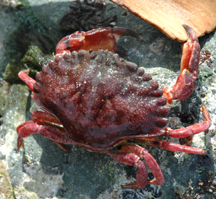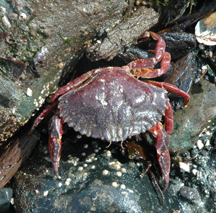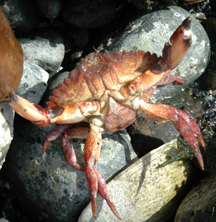
![]()
Red Rock Crab (Cancer Productus)
Other Names: Red Crab, Cancer Crab, Red Cancer Crab.
Photo 1: View of carapace and extended claw.
This crab is characterized by its deep red shell and black tipped pincers. Juveniles are common on rocky, gravelly beaches near the low-tide line and the subtidal zone. However, being nocturnal, you will have to search for a partially exposed carapace buried in the gravel. Red rock crabs are not usually found in muddy or sandy areas because they lack gill strainers like other crabs. Not to be trifled with, this crab has a nasty pinch. It is a carnivorous predator and regularly uses its claws to crack open barnacles, mussels, clams, snails, and even smaller crabs. The juveniles are in turn eaten by rockfish and octopuses. Adults are eaten by sea otters and humans. (Taken at Willow Point, Campbell River)
Photo 2: Red rock crab scurrying to safety.
The red rock crab is not as commercially sought after as the Dungeness crab because of its thick, hard-to-break shell. However, as harvesting pressure makes the Dungeness harder to come by, more and more red rocks are making their way to the pot. Both Dungeness and red rock crabs may require 'no take' areas to assure their continued survival. (Taken at Willow Point, Campbell River)
Photo 3: Underbelly of a red rock crab.
Note the absence on red spots. The easiest way to distinguish the brown rock crab, or Pacific rock crab, is to look for red spots. The brown rock crab has unmistakable spots underneath. Note however, the red rock crab may have light orange or red blotches underneath, but there should be no confusion once you've seen the spots on the brown rock crab. (Taken at Willow Point, Campbell River)



Other Pacific Northwest Crabs: Black-clawed Crab, Kelp Crab, Porcelain Crab
